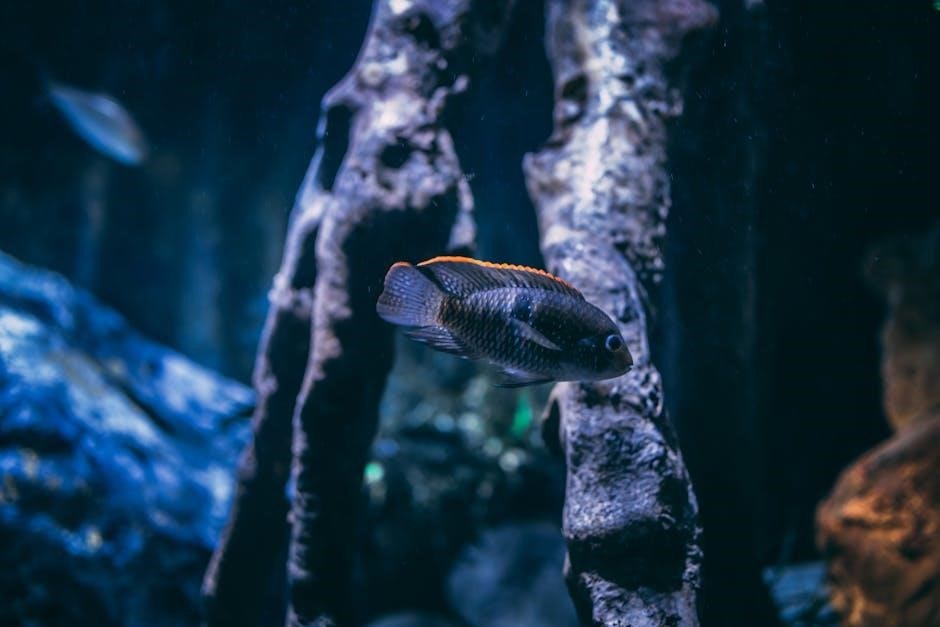
planted fish tank guide
A planted fish tank combines the beauty of aquatic plants with the vibrancy of fish, creating a thriving ecosystem. This guide will help you set up and maintain a stunning aquarium that promotes harmony between plants and fish, enhancing both aesthetics and water quality. Whether you’re a beginner or an experienced hobbyist, this comprehensive guide provides essential insights to foster a healthy, balanced environment for your underwater world.
Benefits of Planted Aquariums
Planted aquariums offer numerous benefits for both fish and their environment. Plants provide oxygen, improving water quality, while absorbing carbon dioxide and excess nutrients. This natural filtration reduces algae growth and stabilizes water parameters. Additionally, plants create a welcoming habitat for fish, offering shelter, food, and breeding grounds. The symbiotic relationship between plants and fish enhances biodiversity and ecosystem balance, making the aquarium more sustainable. A thriving planted tank also adds aesthetic beauty, creating a calming and visually stunning underwater world for enjoyment.
Overview of the Guide
This comprehensive guide is designed to help you successfully create and maintain a thriving planted fish tank. It covers essential topics such as choosing the right equipment, selecting appropriate plants, and understanding proper tank setup. You’ll learn about the benefits of planted aquariums, how to care for your plants and fish, and tips for avoiding common mistakes. Whether you’re a beginner or an experienced aquarist, this guide provides a clear roadmap to building and sustaining a stunning underwater ecosystem.
Choosing the Right Tank for Your Planted Aquarium
Selecting the right tank is crucial for a thriving planted aquarium. Consider size, shape, and clarity to ensure optimal plant growth and a visually appealing setup.
Factors to Consider: Size, Shape, and Clarity
When selecting a tank for your planted aquarium, consider size, shape, and clarity. A larger tank provides stability, while shape affects aquascaping possibilities. Clear glass ensures optimal light penetration for plant growth. Avoid placing tanks in direct sunlight to prevent algae overgrowth. Proper size and clarity enhance the aesthetic appeal and health of your aquarium, supporting both plants and fish. Research and plan carefully to create a balanced ecosystem;
Recommended Tank Sizes for Beginners
For beginners, a 10-gallon tank is an ideal starting point, offering a manageable size for maintaining stable water conditions. A 20-gallon tank provides more space for plants and fish, enhancing stability and versatility. Smaller tanks, like 5 gallons, are great for tight spaces but require careful monitoring. Larger tanks, such as 30 gallons, are better for experienced hobbyists. Starting with a 10-20 gallon tank allows for a balanced ecosystem and easier maintenance, making it perfect for those new to planted aquariums.
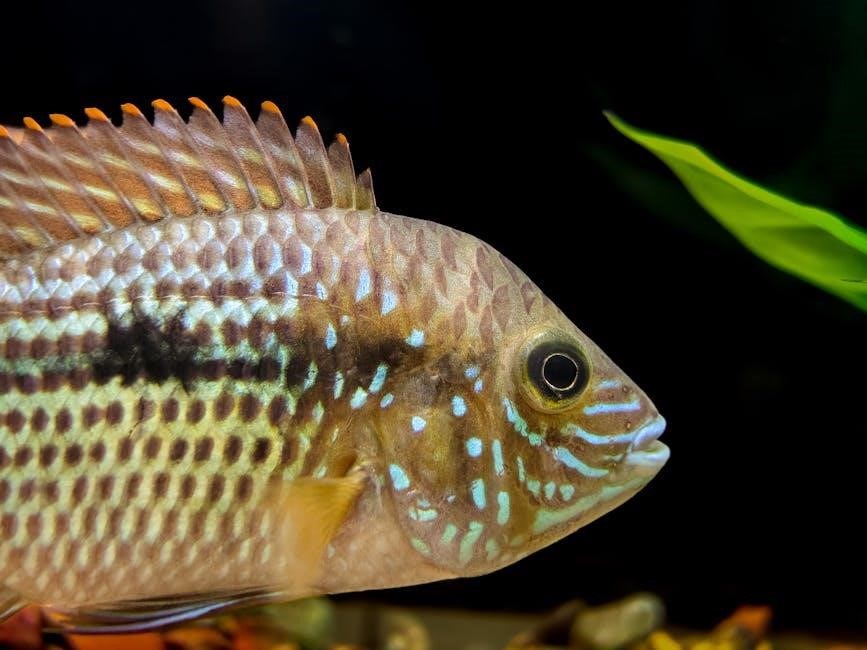
Selecting the Right Plants for Your Tank
Choosing the right plants ensures a thriving aquarium. Popular options like Java Moss, Amazon Sword, and Java Fern are ideal for beginners, adapting to various conditions. These plants enhance water quality and provide natural habitats for fish, creating a balanced ecosystem.

Popular Aquarium Plants for Beginners
Java Moss, Amazon Sword, and Java Fern are excellent choices for beginners. Java Moss is low-maintenance and grows on surfaces, while Amazon Swords have striking leaves. Java Ferns thrive in low-light conditions and attach to wood. These plants are hardy and adapt easily to various tank conditions, making them perfect for new aquarists. They provide shade and improve water quality, benefiting both fish and the aquarium’s ecosystem. These plants are ideal for creating a lush, vibrant environment.
How to Choose Plants That Match Your Tank’s Conditions
Assess your tank’s lighting, temperature, pH, and substrate to select plants that thrive in those conditions. Low-light plants like Java Ferns or Anubias are ideal for tanks with limited illumination, while high-light plants like Amazon Swords require stronger lighting. Consider water temperature ranges and pH levels, as plants like Vallisneria prefer cooler waters, while others tolerate warmer conditions. Match substrate needs—coarse gravel for rooted plants, or attach Java Moss to hardscape. This ensures harmony and optimal growth in your aquarium ecosystem.
Plant Placement and Aquascaping Tips
Plan your aquascape to create balance and visual appeal. Place taller plants like Amazon Swords or Vallisneria in the background, mid-sized plants such as Anubias or Cryptocorynes in the middle, and carpeting plants like Java Moss or Eleocharis in the foreground. Use hardscapes like rocks or driftwood to create focal points and separate plant groups. Avoid overcrowding to ensure proper light and nutrient distribution. Maintain open spaces for fish to swim, enhancing the tank’s natural flow and aesthetic harmony.
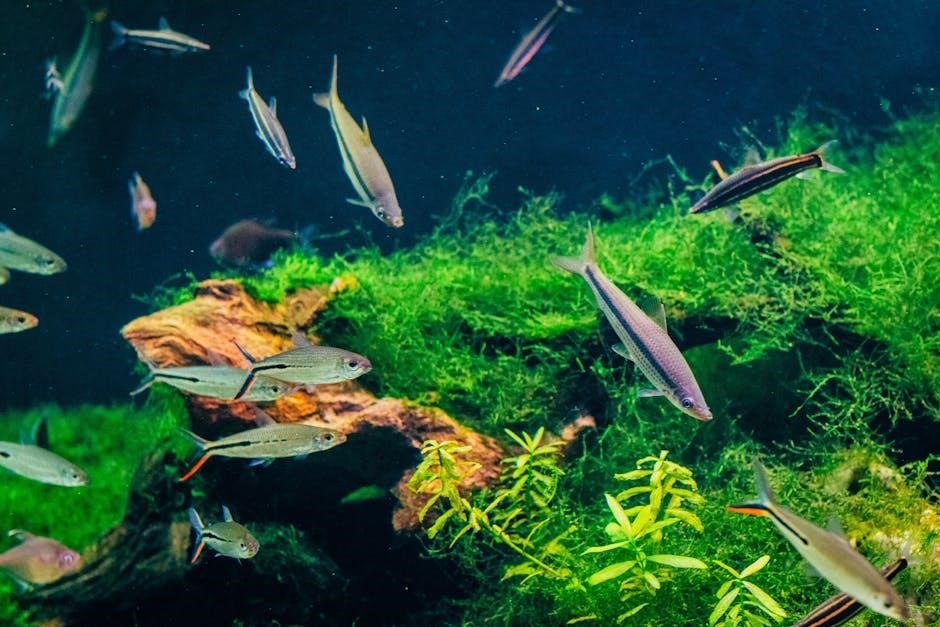
Essential Equipment for a Planted Fish Tank
Proper equipment is crucial for a thriving planted aquarium. Lighting, filtration, substrate, and heating/cooling systems are key to supporting plant growth and maintaining stable water conditions. Investing in high-quality tools ensures a healthy ecosystem for both plants and fish, promoting long-term success and aesthetic appeal.
Lighting: Types and Duration
Lighting is crucial for plant photosynthesis and aesthetics. LED lights offer adjustability, while T5 and T8 bulbs provide specific spectrums. Low-light plants like Java Moss thrive with basic lighting, but Amazon Swords need stronger illumination. Matching light intensity to plant needs is vital. A 6-8 hour photoperiod prevents algae growth. Avoid direct sunlight to maintain stable conditions and ensure plant health. Proper lighting creates a balanced ecosystem, promoting both plant growth and fish well-being;
Filtration: Choosing the Right System
Filtration is essential for maintaining clean water and a healthy environment. For planted tanks, canister or hang-on-back filters are ideal, providing efficient water circulation and biological support. Sponge filters are another option, offering gentle flow suitable for delicate plants. Ensure the filter matches your tank size and flow requirements. Proper filtration prevents waste buildup, promotes plant growth, and sustains fish health, creating a balanced ecosystem in your planted aquarium.
Substrate: Nutrient-Rich Options for Plant Growth
Choosing the right substrate is crucial for plant growth in a planted aquarium. Opt for nutrient-rich substrates like aquarium soil or gravel specifically designed for planted tanks. These substrates provide essential minerals and support root development. Avoid regular gravel, as it lacks the necessary nutrients. Layering soil with a coarse substrate can enhance water circulation and prevent compaction. Additionally, adding fertilizer tablets or liquid nutrients can boost plant health and ensure vibrant growth in your aquatic garden.
Heating and Cooling: Maintaining Optimal Water Temperature
Maintaining consistent water temperature is vital for plant and fish health. Heaters are essential for tropical setups, while cooling systems like fans or chillers prevent overheating. Avoid placing tanks near direct sunlight or heat sources. Use a thermometer to monitor temperatures and ensure stability. Fluctuations can stress plants and fish. Optimal temperature ranges vary by species, so research specific needs. A stable environment promotes healthy growth and prevents disease, ensuring a thriving ecosystem in your planted aquarium.

Setting Up Your Planted Fish Tank
Setting up a planted fish tank involves careful planning and execution. Start by preparing the tank, adding substrate, and arranging hardscape. Plant selection and placement follow, ensuring a balanced ecosystem. Cycle the tank to establish beneficial bacteria before introducing fish. Regular water changes and maintenance are crucial for long-term success. This guide provides a step-by-step approach to creating a thriving planted aquarium that supports both plants and fish harmoniously.
Step-by-Step Guide to Tank Setup
Begin by cleaning the tank thoroughly with vinegar and water to remove any residue. Place the tank on a stable surface away from direct sunlight. Add a nutrient-rich substrate, ensuring even distribution. Install essential equipment like lighting, filtration, and heating; Arrange hardscape elements such as rocks or driftwood to create visual interest. Plant your chosen aquarium plants, securing them in the substrate. Cycle the tank for 2-4 weeks to establish beneficial bacteria before introducing fish. Finally, add dechlorinated water and monitor the environment for stability.
Adding Substrate and Hardscape
Start by adding a nutrient-rich substrate, spreading it evenly across the tank base. For planted tanks, a soil-based substrate is ideal for plant root growth. Next, arrange hardscape elements like rocks or driftwood to create a visually appealing layout. Place larger rocks first, followed by smaller ones, ensuring stability. Avoid placing hardscape directly on the glass bottom to prevent cracking; Secure plants to hardscape using twine or fishing line, allowing them to grow naturally without shifting. This step sets the foundation for a balanced ecosystem.
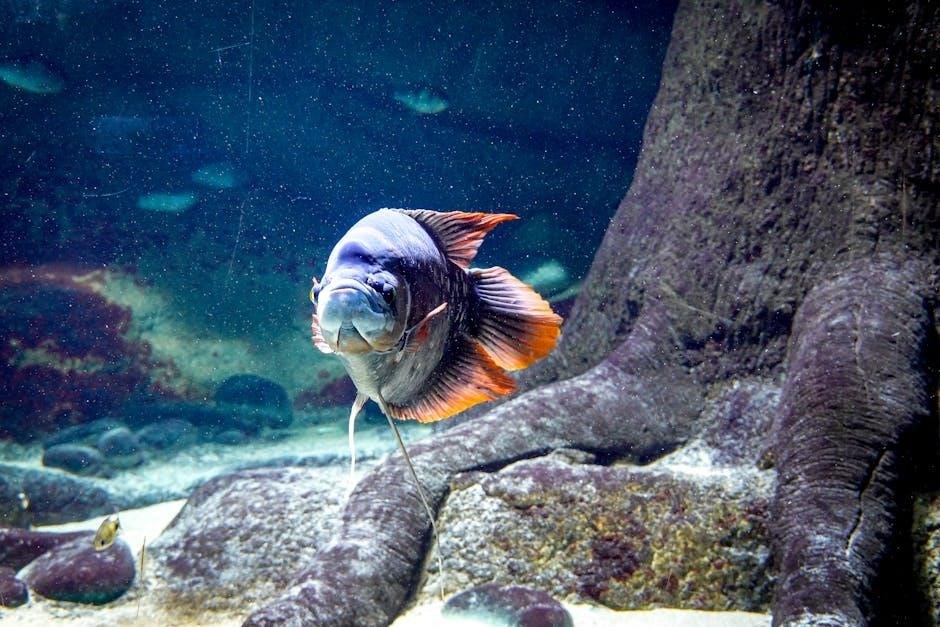
Planting Your Aquarium
Planting is a critical step in creating a thriving aquarium. Begin with carpeting plants or mosses to cover the substrate, ensuring a lush base. Mid-ground plants like Amazon Swords or Vallisneria add depth, while background plants provide height. Use a planting tool or your hands to gently place each plant, securing them in the substrate. For plants without roots, attach them to rocks or driftwood using twine or fishing line. Proper placement enhances aesthetics and promotes healthy growth, creating a natural habitat for fish and improving water quality.
Cycling the Tank Before Adding Fish
Cycling your tank is essential before introducing fish. This process establishes beneficial bacteria to convert waste into nitrates, ensuring a safe environment. Allow the tank to cycle for 2-3 weeks, maintaining proper water flow and oxygen levels. Plants play a crucial role by producing oxygen and absorbing nutrients. Avoid adding fish too soon, as this can disrupt the balance and harm aquatic life. Patience during this phase ensures a healthy, thriving ecosystem for both plants and fish.
Adding Water and Final Adjustments
Once your tank is cycled and ready, carefully add dechlorinated water to avoid shocking the beneficial bacteria. Pour the water slowly to prevent disturbing the substrate and plants. Monitor water parameters like pH, ammonia, and nitrite levels to ensure stability. Make any final adjustments to lighting, filtration, or heating as needed. Allow the tank to settle for 24 hours before introducing fish, ensuring a balanced and thriving environment for your aquatic ecosystem.
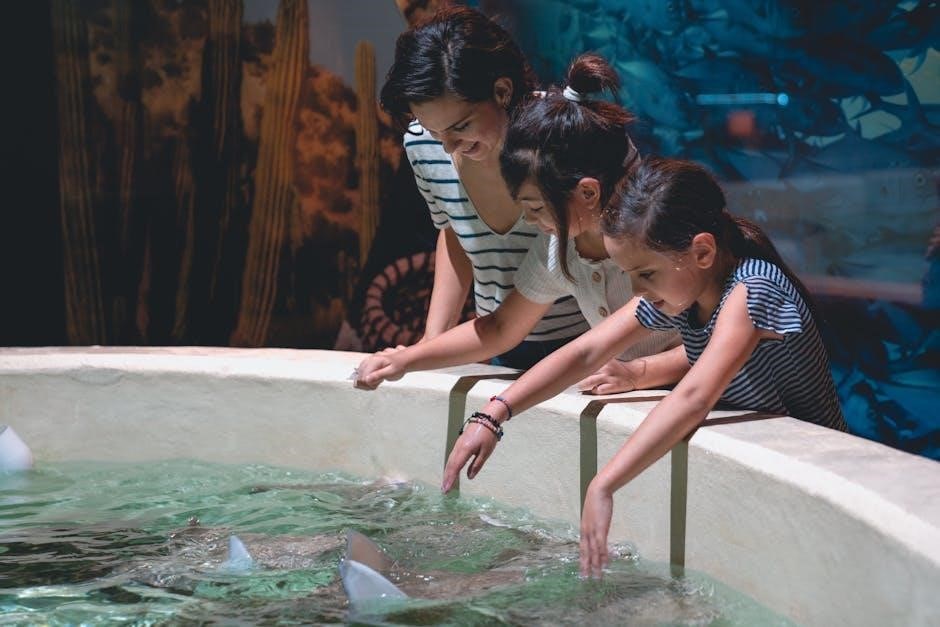
Introducing Fish to Your Planted Tank
Wait until your tank is fully cycled and stable before adding fish. Choose species compatible with aquatic plants and acclimate them slowly to avoid stress.
Choosing Fish Compatible with Planted Aquariums
Selecting the right fish for your planted tank is crucial for a harmonious ecosystem. Opt for small, peaceful species like Neon Tetras or Galaxy Rasboras that complement the plants. Avoid herbivorous fish, as they may eat your plants. Otocinclus Catfish and Siamese Algae Eaters are excellent choices for algae control. Larger species like Angelfish or Discus can thrive if the tank is spacious. Ensure compatibility by researching their needs and behaviors to create a balanced environment where both fish and plants flourish together naturally.
Acclimating Fish to the Tank Environment
Acclimating fish to your planted tank is essential to prevent shock and stress. Float the unopened fish bag in the tank for 15-20 minutes to equalize water temperature. Gradually mix tank water into the bag to adjust fish to pH and chemical levels. Release the fish gently, avoiding netting stress. This process ensures a smooth transition, promoting their health and adaptation to the new environment. Proper acclimation is key to maintaining their well-being in your thriving planted aquarium ecosystem.
Maintenance and Care of Your Planted Tank
Regular maintenance ensures the health of your planted tank. Monitor water parameters, perform partial water changes, and clean equipment. Balance nutrients for plant growth and fish well-being.
Daily and Weekly Maintenance Tasks
Daily, inspect your tank for algae growth and plant health. Perform water tests to monitor pH, ammonia, and nitrate levels. Weekly, change 10-15% of the water using a gravel vacuum to remove debris. Trim or prune overgrown plants to maintain aesthetics and promote healthy growth. Clean algae from glass walls using a magnetic scrubber. Ensure all equipment, like filters and heaters, is functioning properly to maintain optimal water conditions for both plants and fish.
Monthly Maintenance: Cleaning and Upkeep
Monthly maintenance involves a deeper clean to ensure your tank remains healthy. Replace carbon filters and clean mechanical filter media to maintain water clarity. Scrub stubborn algae from decorations and glass using algae-specific tools. Inspect and clean the substrate by siphoning debris from the gravel. Check and adjust equipment settings, such as heaters and CO2 injectors, to ensure they are functioning correctly. This routine upkeep prevents issues like nutrient imbalances and keeps your ecosystem thriving.

Common Mistakes and Troubleshooting
Common mistakes include overstocking fish, inadequate lighting, and improper substrate choice. Troubleshooting algae issues and plant health problems requires adjusting water parameters and maintenance routines.
Avoiding Common Errors in Planted Tanks
One of the most common mistakes in planted tanks is overstocking with fish, which can lead to poor water quality and stress on plants. Additionally, inadequate lighting duration or intensity can cause plants to wither or algae to overgrow. Another error is using the wrong substrate, as plants require nutrient-rich soil to thrive. Lastly, insufficient cycling time before adding fish can disrupt the ecosystem, leading to plant and fish health issues. Proper planning and research are key to avoiding these pitfalls.
Troubleshooting Algae and Plant Health Issues
Algae growth is a common issue in planted tanks, often caused by excess light or nutrients. Identify the algae type—such as hair algae or green spot algae—and adjust lighting duration or intensity. For plant health, yellowing leaves or slow growth may indicate nutrient deficiencies or poor lighting. Regularly test water parameters and ensure proper CO2 levels. Introduce algae-eating fish like Otocinclus or Siamese Algae Eaters to maintain balance. Addressing these issues promptly prevents ecosystem disruption and promotes a thriving environment for both plants and fish.
With patience and dedication, your planted fish tank will flourish, offering a serene and vibrant aquatic environment. Enjoy the beauty of nature in your home, knowing your efforts nurture a thriving ecosystem for both plants and fish alike.
Final Tips for Success
To ensure your planted aquarium thrives, maintain consistent water parameters and lighting schedules. Regularly monitor plant health and algae growth. Avoid overstocking with fish, as this can disrupt the balance. Invest in a high-quality filtration system to keep water clean and oxygen-rich. Perform partial water changes weekly to replenish nutrients and remove waste products. Lastly, observe and enjoy your tank daily, as it evolves into a stunning underwater garden.
Enjoying Your Thriving Planted Aquarium
A thriving planted aquarium is a source of endless joy and relaxation. Watching your plants flourish and fish thrive creates a sense of accomplishment and connection to nature. The vibrant colors and dynamic ecosystem bring life to any room. Take time to appreciate the intricate details of your aquascape and the symbiotic relationship between plants and fish. Whether it’s the serene beauty of a Dutch-style layout or the natural charm of a jungle-inspired tank, your aquarium is a living masterpiece to cherish and share with others.